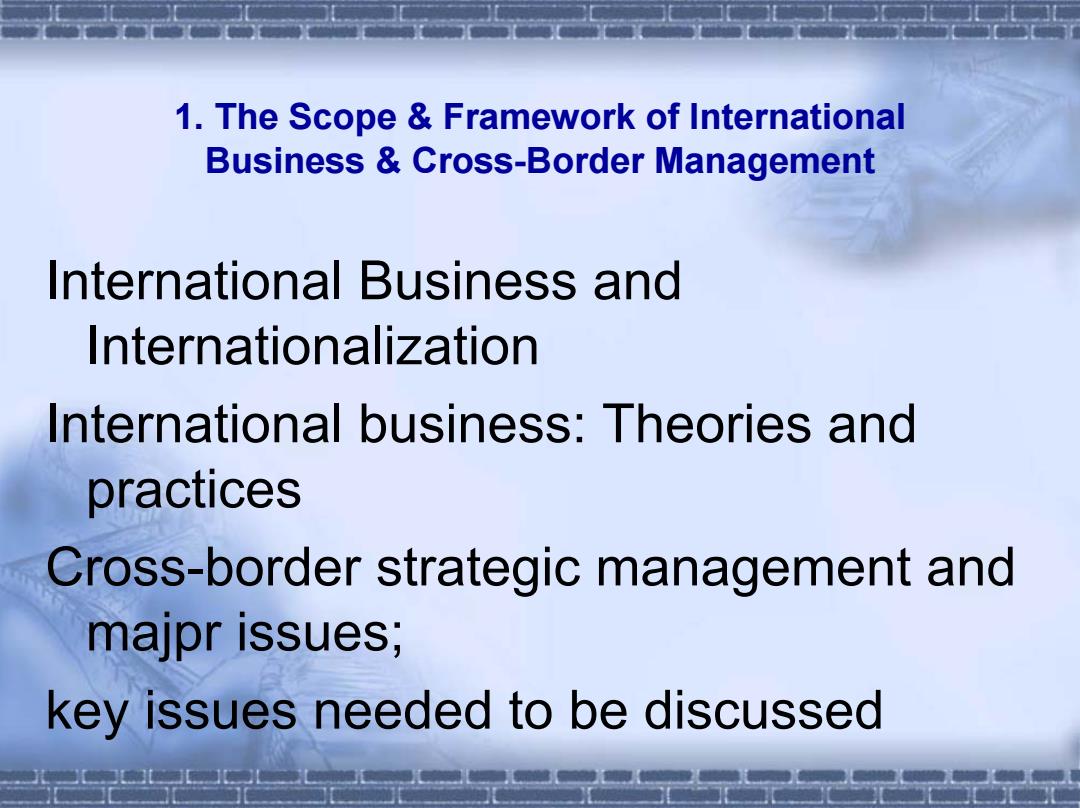
第一篇导论 第一章跨国公司与跨国经营
第一篇 导论 第一章 跨国公司与跨国经营

第一节跨国经营 Guidelines of International Business and Multi-National Management(MNCs)
第一节 跨国经营 Guidelines of International Business and Multi-National Management(MNCs)

1.The Scope Framework of International Business Cross-Border Management International Business and Internationalization International business:Theories and practices Cross-border strategic management and majpr issues; key issues needed to be discussed
1. The Scope & Framework of International Business & Cross-Border Management International Business and Internationalization International business: Theories and practices Cross-border strategic management and majpr issues; key issues needed to be discussed

2.International Business International business takes place when business carried out across national borders. International business as a field of management education deals with the special features of business activities that cross borders. These activities may be movements of goods, services,capital,or personnel;transfers of technology,knowledge,information,or data
2. International Business International business takes place when business carried out across national borders. International business as a field of management education deals with the special features of business activities that cross borders. These activities may be movements of goods, services, capital, or personnel; transfers of technology, knowledge, information, or data

3,MNCs An Enterprise (a)comprising entities in two or more countries, regardless of the legal form and fields of activity of these entities, (b)which operates under a system of decision-making, permitting coherent policies and a common strategy through one or more decision-making centers,(c)in which the entities are so linked,by ownership or otherwise,that one or more of them may be able to exercise a significant influence over the activities of others,and,in particular,to share knowledge,resources and responsibilities with the others
3. MNCs An Enterprise (a) comprising entities in two or more countries, regardless of the legal form and fields of activity of these entities, (b) which operates under a system of decision-making, permitting coherent policies and a common strategy through one or more decision-making centers, (c) in which the entities are so linked, by ownership or otherwise, that one or more of them may be able to exercise a significant influence over the activities of others, and , in particular, to share knowledge, resources and responsibilities with the others

In essence,this definition pays more attention on the importance of strategic and organizational integration and,thereby,management integration of operations located in different countries iS regarded as the key differentiating characteristic of an MNC. What really differentiates t the MNC is that it creates an internal organization to carry out key cross-border tasks and transactions internally rather than depending on trade through the open markets
In essence, this definition pays more attention on the importance of strategic and organizational integration and, thereby, management integration of operations located in different countries is regarded as the key differentiating characteristic of an MNC. What really differentiates the MNC is that it creates an internal organization to carry out key cross-border tasks and transactions internally rather than depending on trade through the open markets

1.Structural Criterion (1)Operations location (2)Value activities'Facilities and relationship (3)Ownership 0 2.Transnationality 3.Attitude toward international business (ethnocentric, polycentric,and geocentric)
1. Structural Criterion (1) Operations location (2) Value activities’ Facilities and relationship (3) Ownership 2. Transnationality 3. Attitude toward international business (ethnocentric, polycentric, and geocentric)

表1-1跨国度位居前列的企业和行业 1998年 1998年 1997年 1997年 依据国 依据跨 依据国 依据跨 公司名称 国别 行业(Industry) 跨国指 外资产 国指数 外资产 国指数 数(TND) 排名 排名 排名 排名 34 1 23 1 Seagram Company Canada Beverage/Media 94.8 57 2 52 3 Thomson Canada Media/Publishing 94.6 Corporation 10 3 9 4 Nestle SA Switzerla Food/beverages 94.2 nd 82 4 74 7 Electronics AB Sweden Electrical equipment/electronics 92.7 69 5 77 37 British American United Food/tobacco 91 Tobacco Ple Kingdom 62 6 89 11 Holderbank Finance Switzerla Construction materials 90.5 Glarus nd 12 18 5 Unilever Netherlan Food/beverage 90.1 ds/UK 15 8 14 2 ABB Switzerla Electrical equipment 89.1 nd 71 9 94 24 Smithkline Beecham UK Pharmaceuticals 82.3 Plc 98 10 New New SCA Sweden Paper 80.8 资料来源:2000 World Investment Report,p79
表1-1跨国度位居前列的企业和行业 98 10 New New SCA Sweden Paper 80.8 Smithkline Beecham UK Pharmaceuticals 82.3 Plc 71 9 94 24 Switzerla Electrical equipment 89.1 nd 15 8 14 2 ABB Netherlan Food/beverage 90.1 ds/UK 12 7 18 5 Unilever Switzerla Construction materials 90.5 nd Holderbank Finance Glarus 62 6 89 11 United Food/tobacco 91 Kingdom British American Tobacco Plc 69 5 77 37 82 4 74 7 Electronics AB Sweden Electrical equipment/electronics 92.7 Switzerla Food/beverages 94.2 nd 10 3 9 4 Nestle SA Thomson Canada Media/Publishing 94.6 Corporation 57 2 52 3 34 1 23 1 Seagram Company Canada Beverage/Media 94.8 跨国指 数(TNI) 公司名称 国别 行业(Industry) 1997年 依据跨 国指数 排名 1997年 依据国 外资产 排名 1998年 依据跨 国指数 排名 1998年 依据国 外资产 排名 资料来源:2000 World Investment Report, p 79

管理视角1-3:全球最大的100家跨国公司的行业分布 The industry composition of the top 100 TNCs in 1999 (I)电子、电气设备、计算机(Electronics/electrical equipment//computers) (2)汽车与零部件(Motor vehicle and part) (3)石油开采、炼制、分销(Petroleum Exploration/refining/distribution) (4)食品、饮料、烟草(Food/beverage/.tobacco) (S)化工、医药(Chemicals/pharmaceuticals) (6)多元化(Diversified) (7)电信(Telecommunications) (8)贸易(Trading) (9)零售(Retailing) (10)公用事业(Utilities)
管理视角 1-3:全球最大的 100 家跨国公司的行业分布 The industry composition of the top 100 TNCs in 1999 (1)电子、电气设备、计算机(Electronics/ electrical equipment/ computers) (2)汽车与零部件(Motor vehicle and part) (3)石油开采、炼制、分销(Petroleum Exploration/ refining/distribution) (4)食品、饮料、烟草(Food/ beverage/ tobacco) (5)化工、医药(Chemicals/ pharmaceuticals) (6)多元化(Diversified) (7)电信(Telecommunications) (8)贸易(Trading) (9)零售(Retailing) (10)公用事业(Utilities)

表1-2跨国公司总部对海外子公司价值导向三种类型 (Three types of headquarters orientation toward subsidiaries in an international enterprise) 组织设计 母国取向 东道国取向 世界取向 组织的复杂性 国采取复杂的组织形 变化且独立 复杂性和相互依赖性逐渐增加 式 决策权 总部权威 相对集中在总部 在总部和子公司之间协作以达成目 标 评价和控制 采用母国标准 由当地决定 寻求全球性和地区性的标准 奖励和惩罚 总部较高,子公司较低 变化较大;对公司绩效可 达到全球或地区目标的执行官受到 采用或高或低的奖励 奖励 沟通:信息流 对子公司沟通量大:命 与总部沟通较少;子公司 母子公司之间双向沟通。子公司领 令、指挥、建议。 之间的信息流也较少 导为母公司管理团队成员 国籍 所有者国籍 东道国国籍 完全国际化的公司,但认同其国家 利益 人员聘用(雇 雇佣并开发母国人员, 开发具有东道国国籍的人 在世界各地培养子公司职位的最佳 佣,人员配备, 任命其担任在世界各地 员并任命其担任母公司在 人选 人力开发) 的子公司主要职位 该国的子公司的主要职位 Howard V.Perlmutter(1969),The Torturous Evolution of Multinational Corporation,in Columbia Journal of World Business,January,pp.9-18
表1-2 跨国公司总部对海外子公司价值导向三种类型 (Three types of headquarters orientation toward subsidiaries in an international enterprise) 在世界各地培养子公司职位的最佳 人选 开发具有东道国国籍的人 员并任命其担任母公司在 该国的子公司的主要职位 雇佣并开 任命其担 的子公司 人员聘用 (雇 佣,人员配备, 人力开发) 发母国人员, 任在世界各地 主要职位 完全国际化的公司,但认同其国家 利益 国籍 所有者国籍 东道国国籍 母子公司之间双向沟通。子公司领 导为母公司管理团队成员 与总部沟通较少;子公司 之间的信息流也较少 对子公司沟通量大;命 令、指挥、建议。 沟通;信息流 达到全球或地区目标的执行官受到 奖励 变化较大;对公司绩效可 采用或高或低的奖励 奖励和惩罚 总部较高,子公司较低 评价和控制 采用母国标准 由当地决定 寻求全球性和地区性的标准 在总部和子公司之间协作以达成目 标 决策权 总部权威 相对集中在总部 母国采取复杂的组织形 变化且独立 复杂性和相互依赖性逐渐增加 式 组织的复杂性 组织设计 母国取向 东道国取向 世界取向 资料来源:Howard V. Perlmutter (1969), The Torturous Evolution of Multinational Corporation, in Columbia Journal of World Business, January, pp. 9-18